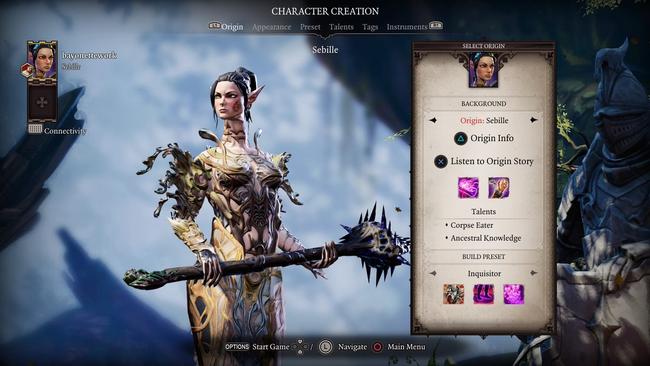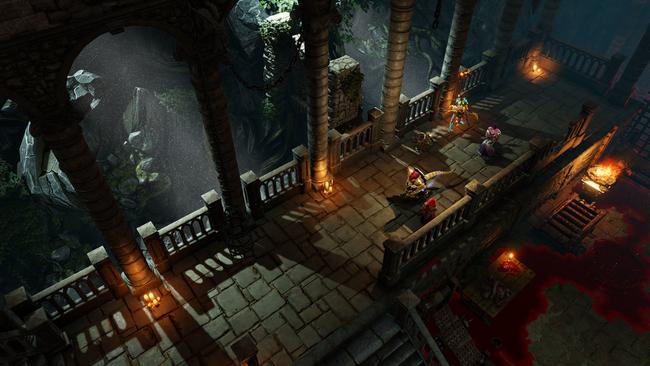
Divinity: Original Sin II - Definitive Edition Console Review
Since the series' reincarnation in 2014 with Divinity: Original Sin, Larian Studios has breathed new life into isometric RPGs that certainly stands out among its peers. Upon the original PC release last year, Divinity: Original Sin II was widely hailed as one of the best Western RPGs of the past decade. It goes without question that Larian Studios has crafted a unique and deeply immersive experience, and it has only gotten better with this year's Divinity: Original Sin II - Definitive Edition.
Divinity: Original Sin II has a handful of different difficulties for players to choose from in order to tailor their experience to their liking. These difficulties include Explorer Mode, Classic Mode, Tactician Mode, and the new frustration-free Story Mode. Additionally, selecting Tactician Mode allows for a branching path of two additional difficulty settings as well. For this review, I played both the Story and Classic difficulties to get a feel for the key differences between the two.
Classic Mode is just as its name suggests, it is the standard difficulty, and for those that have played Divinity: Original Sin - Enhanced Edition, they’ll find it comparable to the standard difficulty of that game as well. This difficulty presents a hard but fair level of challenge and players will need to be resourceful to stay ahead in encounters.

I’d also suggest saving at every encounter if you choose to play Classic Mode if you’re unfamiliar with Divinity or similar isometric RPGs such as the Pillars of Eternity or Baldur’s Gate franchises. Reloading before encounters will be vital in some situations if you’re not well prepared, but this can also be mildly frustrating at times as the game's loading times aren’t exactly the fastest, at least on PlayStation 4. I sometimes found myself just living with the consequences of a fight gone horribly awry because I didn’t want to sit through a loading screen for a third or fourth time.
While I found Classic Mode's level of challenge to still be fairly enjoyable, it was minor frustrations like these that pushed me to give the Story Mode a fair shake. Story Mode allows players to defeat encounters with little difficulty - some fights do still pose something of a challenge, but standard encounters progressed fairly smoothly in comparison to Classic Mode. Story Mode allows for the narrative to shine, and while combat is really fun in Divinity: Original Sin II, I was more than happy progressing through the story without having to reload before more difficult encounters or have a lack of gear or levels barring my progress.
Unique multiplayer options do exist in Divinity: Original Sin II, just as they did in the original. Yet, this time your party can have up to four people in it at a time instead of being relegated to two players and two NPCs. Players can join online games through the Story Menu on the start screen, joining friends in cooperation through their own playthrough in the world of Rivellon. For those that prefer local co-op, the two player split-screen co-op mode is still available. However, during my rather extensive testing with the local co-op mode, I had some difficulty with a few odd graphical glitches and other issues. Occasionally when entering areas with candlelight or torches on the left side of the screen (if split), it would cause certain textures to start flickering to black. Odd visual bugs like these would only stop if the split-screen was deactivated or upon reloading the game.
Additionally, sometimes after initiating dialogue with NPCs the forced split-screen would automatically deactivate if my co-op partner was in the same area, causing me to go back into the menu to reactivate it every time this happened. While altogether minor issues, they did discourage me from continuing local co-op mode because these frustrating glitches ended up being quite hard on my eyes and patience after around thirty minutes or so of gameplay.

Controls on the PlayStation 4 version of Divinity: Original Sin II are exactly as they were in the first game. For new players jumping into Divinity, this means learning to love the use of radial menus. You will be using every button on your controller, and while it can be a bit daunting at first, there is a very handy tutorial at the beginning of the story that guides you through all the bells and whistles of conversation, combat, dialogue, stealth, and basic exploration. With just a small amount of acclimation, I didn’t have any problems with the controls on the console version and they were very easy to get back into. They also seemed to be slightly more polished than that of the first game in terms of control bugs.
The console UI itself is fairly well laid out and text is easy to read, but some menuing does take some getting used to. New players might find some of the menuing obtrusive until they’ve properly settled down with the game and figured out how to best navigate their inventories and equipment.

A revamped Arena Mode was added with the Definitive Version of Divinity: Original Sin II, and can be played both on and offline. The Arena Mode is exactly what it implies --- players can face off against each other in a set area which can be chosen in the settings, along with other specifications in unique battle scenarios. The amount of time used each turn can be adjusted along with how many characters are allowed per player, alongside other various game modes. I personally didn’t spend a lot of time with this feature since I was more invested in the narrative itself, but for those inclined to tinker with the combat mechanics of Divinity: Original Sin II, the Arena offers a neat toolset to mess around in.
Speaking of the narrative, the character creator works slightly differently compared to the first game. This time around players can pick between making their own character like in the original, or instead, opt to pick from several preset options that have unique backstories and voices. Customization can be done to both original and preset 'Origin' characters so players will always have a say in how their character looks as well as their class, just within a few set limitations such as Origin characters having fixed races.
I played one of the preset characters during my playthroughs and had a really great time with the unique interaction available within their written stories. I picked Ifan ben-Mezd, an outlaw and a soldier so who had unique interactions with NPCs featuring similar specific character tags. This isn't limited to merely unique lines of dialogue, but a few opportunities also arose where I found myself with a certain set of objectives as well. All preset characters have their own paths to follow within the larger narrative, though this is not limited to only playing as them -- NPC companions can be found within the world and recruited into your party, but only four at a time.
You won't be able to see all the stories in a single playthrough, so you’ll need to pick who you’d like to tag along with you. I found this particularly difficult because I ended up liking all of the companions available.

As either a purely custom character or a preset one, you can forge relationships with other members of your party, eventually pursuing a romance with them if you’re inclined. Same-sex relationships are a path you can pursue in Divinity: Original Sin II and I was immensely thankful for that. In fact, you can romance any of the characters regardless of your chosen gender or race. In my playthrough, I ended up growing particularly close to one of the NPC companions, The Red Prince, and pursued a relationship with him as Ifan. The dynamics between specific characters can vary depending on the responses you choose during the story, but in my experience, everything felt very natural through the course of our dialogues with one another.
All of the dialogue is narrated and fully voiced which allows for a greater sense of immersion in the story, and I’ll admit it made my time more enjoyable as well. Pair this with the well-written narrative and the result is truly an incredible experience. Typical Western Fantasy tropes are often subverted in some way and the execution of certain plot points had me eager to continue the story. There is a smart balance between silliness and seriousness, something we touched on in our review of the original PC release.
I had been eagerly anticipating this sequel after playing Divinity: Original Sin years ago, and while Original Sin II's story can easily stand alone, those who played the first entry will recognize more than a few big names being thrown around during the course of the game. The familiar tidbits of lore that tie into the events of the first entry work to elevate Original Sin II's narrative even more.

It goes without saying that I think Original Sin II is a splendid game overall, and the PlayStation 4 port is one worth checking out for those interested in the series. Not only is the story welcoming to both returning fans and newcomers to the franchise, but the various difficulty settings, specifically Story Mode, give an accessible option for beginners to experience this style of gameplay with minimal frustration.
Despite the minor glitches I encountered and overlong loading screens, those issues weren’t nearly enough to turn me away from playing and exploring the world of Rivellon once more. If you’re looking for a sprawling narrative, interesting world, and fantastic character building, this game is absolutely for you. I cannot recommend Divinity: Original Sin II enough.